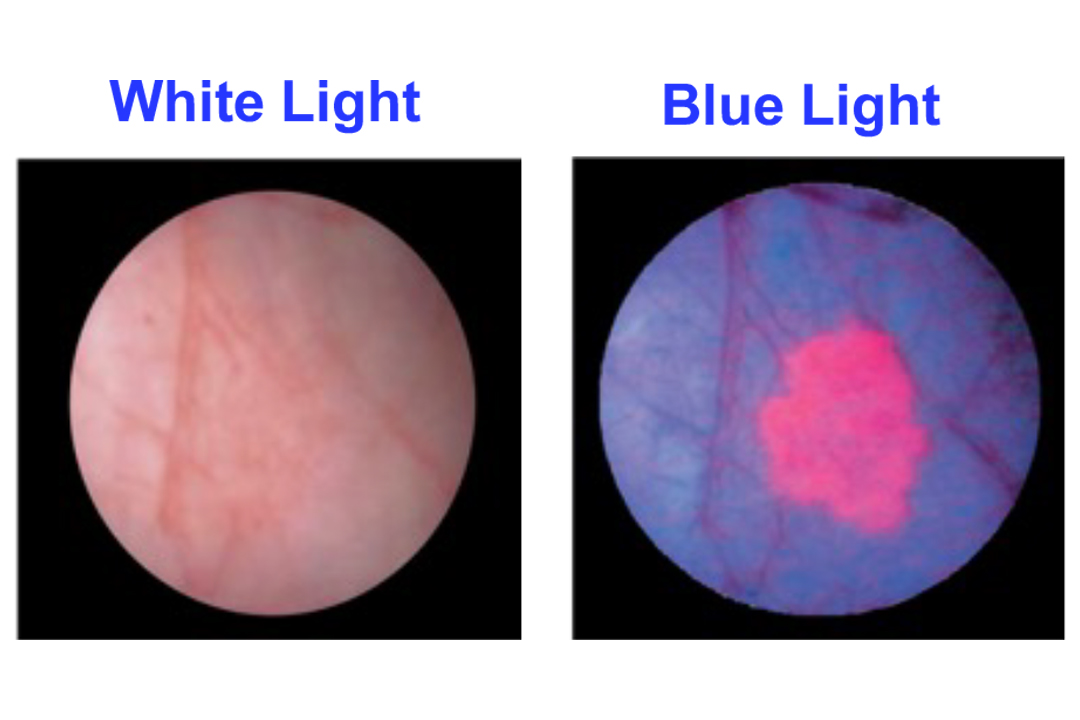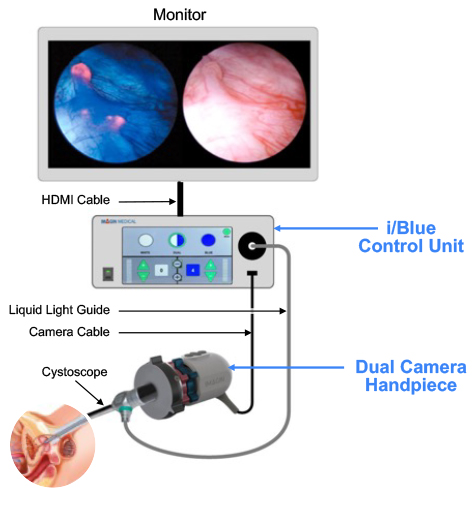Visualizing cancer in vital new ways, starting with bladder cancer
Imagin Medical’s second product, the i/Blue Imaging System, will bring several key technological advancements that improve the utility of blue light imaging for visualizing bladder cancer.
The i/Blue System contains a patented dual view camera head that uses sophisticated optical filtering to display white and blue light images simultaneously side-by-side on the monitor in real time without the need to switch back and forth between the two images. The i/Blue System delivers state-of-the-art blue light imaging technology in a more versatile, practical, and accessible format and is designed to work with existing fiberoptic endoscopes on the market.
Imagin In the OR


Bladder Cancer Statistics*
Bladder cancer is the sixth most common cancer in the U.S. and the most expensive type to treat over the lifetime of a patient.
- 3rd most common cancer in men
- $4B — bladder cancer surveillance
- > 80,000 new cases/year
- > 17,000 deaths annually
- > 700,000 living in fear of recurrence
- > 50% recurrence rate in non-muscle
CURRENT TECHNOLOGY
Today’s Treatment Challenge
Cystoscopy with White Light
The conventional method of detecting bladder cancer uses white light during minimally invasive surgery to illuminate the bladder during a procedure called a cystoscopy.
While light has been used for decades and is the standard for more than 90% of the market. In typical white light cystoscopy, a small camera is mounted at the end of the cystoscope. This enters the body through the urethra into the bladder and projects images onto a surgical monitor. The procedure easily visualizes tumors that protrude above the bladder wall for evaluation and possible removal.
However, when a tumor lies flat against the bladder wall, it is difficult to identify the margins and differentiate from normal tissue. This increases the risk of cancerous cells being left behind, contributing to bladder cancer’s more than 50% recurrence rate.
Cystoscopy with Blue Light
Introduced in 2010, blue light cystoscopy, uses blue-filtered white light to address the limitations of white light cystoscopy.
This method involves administering a contrast agent into the bladder which is absorbed by the cancerous cells, causing them to fluoresce when exposed to blue light. Surgeons are then able to view images of the highlighted cancer cells and more effectively identify flat tumors and their margins for removal. While blue light cystoscopy provides sharper images of the cancer, surgeons still need white light images to get proper orientation within the bladder. Because current technology can only project one image at a time on the surgical monitor, surgeons must switch back and forth between blue and white light images and rely on memory to resect.
Another limitation of this method requires the purchase of new proprietary blue-filter endoscopes that cannot be used for any other purpose.
Even though the American Urological Association recommends blue light cystoscopy as treatment for non muscle invasive bladder cancer, and studies have proven it to be a clinical and cost-effective means of reducing recurrence, only 10% of cystoscopies performed in the U.S. use blue light.
IMAGIN’S CLINICAL SOLUTION
Cystoscopy with the i/Blue™ Imaging System
Imagin Medical’s i/Blue Imaging System addresses the limitations of both white and blue light cystoscopy while maintaining the advantages of both.
By combining innovative optical filtering technology with the same FDA-approved imaging agent, surgeon’s will be able to view real-time, side-by-side white and blue light images on the same monitor, eliminating the need to switch back and forth. This method has the potential to make bladder cancer detection and removal more efficient and accurate, as well as reduce recurrence rates and health care costs.
Unlike current bladder cancer visualization systems, the i/Blue Imaging System is a device external to the body with the capability to attach to most fiberoptic endoscopes currently on the market. As a result, hospitals will be able to integrate Imagin’s technology with endoscopes they already own. While the current blue light method requires a system tower that houses the light source, camera control and video data recorder units, the i/Blue Imaging System consolidates this instrumentation, combining these three modules into one compact device.
Imagin has developed functional units of its i/Blue Imaging System which, when bench tested, met FDA standards and exceeded goals for product performance. The company has defined a regulatory path to achieve FDA approval. Imagin’s intellectual property is well-protected with additional patents being filed based on final design innovation.
Imagin has developed functional units of its i/Blue Imaging System which, when bench tested, met FDA standards and exceeded goals for product performance. The company has defined a regulatory path to achieve FDA approval. Imagin’s intellectual property is well-protected with additional patents being filed based on final design innovation.
Benefits of the i/Blue Imaging System™
- Makes blue light cystoscopy practical and more accessible to hospitals and patients
- Enhances visualization of cancerous cells for more accurate removal
- Displays simultaneous, side-by-side white and blue light images on the monitor
- Eliminates the need for surgeons to switch back and forth
- Shows cancer in context within the bladder
- Consolidates state-of-the-art light source, camera control and video data recorder into one compact device
- Designed to work with existing fiberoptic endoscopes on the market, allowing hospitals to use surgical equipment they already own
Imagin intends to build on the i/Blue Imaging System, which is being developed for use with hexaminolevulinate hydrochloride (HAL) and adapt its technology to other FDA-approved contrast agents, such as Indocyanine green (ICG). Such future products will expand Imagin’s market potential, facilitating entry into multiple endoscopic procedures, such as laparoscopy.




